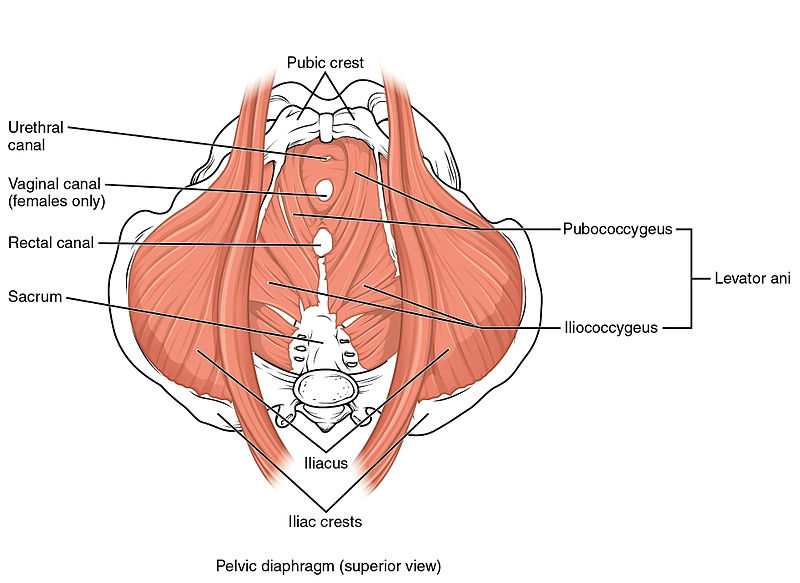“The ability to tense the pelvic floor muscles is critical to improving the function, strength, and endurance of these vital muscles, which are important for continence and supporting the pelvic organs. But many people get it wrong or can not create tension at all. ”
Dr. Maher is Board Certified Specialist for Women’s Health of the American Board of Physical Therapy Specialties (ABPTS).
Due to the growing demand StimaWELL created a unique pelvic floor training program for those in need. Our quick 20 minute program, with multiple smooth electric current sequences, makes sure that you activate the deep muscles in your pelvis area. Combine that with a series of dynamic movements and various techniques to effectively train your pelvic floor.
Often overlooked, the muscles of the pelvic floor can be seen below.
Pelvic Floor Basics
A well-functioning pelvis is the base for continence, it supports our organs and makes sure that there’s no leak. Urinary incontinence is a world-wide problem with an effected population ranging from 4% to 8%.(1) It’s worth noting that the number of people affected by this condition in the entire world has been steadily growing over the last decade. In 2008, 346 million people suffered from UI, while in 2013, 383 million (2).
With the statistics showing an incredible amount of people affected by urinary incontinence, it would be wise to teach young women and men about reinforcing their pelvic floor muscles from an early age in order to reduce the long-term effects of a weak pelvic floor.
Potential Causes of Urinary Incontinence
- Pregnancy
- Childbirth
- Changes with age
- Menopause
- Hysterectomy
- Enlarged prostate
- Prostate cancer
- Obstruction
- Neurological disorder
Types of Urinary Incontinence
Stress Incontinence
Patients suffering from stress incontinence need to learn how to lift their pelvic muscles when they are laughing, coughing, suddenly causing pressure on the bladder, after numerous births, previous operations, generalized weakening of connective tissue, hormone deficiency, genital mutilation, or reduction of reproductive organs. It is more often experienced by older caucasian women categorized by a disorder of urethral hyper-mobility or intrinsic sphincter deficiency (4).
Urge Incontinence
Urge incontinence is caused by abnormal bladder contractions. Urge incontinence can be linked to stroke, Parkinson’s disease, multiple sclerosis and other health conditions which interfere with the brain’s ability to send messages to the bladder via the spinal cord. These conditions can affect a person’s ability to hold and store urine (3). This type of incontinence is usually experienced by older people (5).
Overflow Incontinence
Symptoms include a sudden release of urine, a feeling of fullness in the bladder after urination, leakage of urine while sleeping and difficulty urinating even when feeling the urge to urinate. Overflow incontinence is the involuntary release of urine—due to a weak bladder muscle or to blockage—when the bladder becomes overly full, even though the person feels no urge to urinate (4).
Functional Incontinence
A physical or mental impairment keeps you from making it to the toilet in time (4). For example, if you have severe arthritis, you may not be able to unbutton your pants in time.
Mixed Incontinence
You experience various forms of urinary incontinence.
Treatment with Mid-Frequency Electrotherapy

Thanks to our modulated medium-frequency current electrical signals go very deep inside the body which makes it possible to reach deep-seated motor nerves or to trigger contraction directly in the muscles (depending on the setting by the electrotherapist).
Science speaks of the ‘quasi-physiological’ effect of modulated medium frequency. More muscle groups can thus be reached and trained in comparison to traditional pelvic floor reinforcement methods, low frequency EMS training or other forms or a transvaginal or transanal probe EMS currents.
The Clear Advantage
The contraction process is directly activated during medium-frequency stimulation over the entire muscle. The bypassing of the nerve fibre network and the quasi-physiological contraction state therefore clearly distinguish it from low-frequency stimulation. It offers a non-invasive method for women and men to train their pelvic floor muscles.
Benefits of Pelvic Floor Stimulation with StimaWELL
- Treats the root causes of urinary incontinence
- An effective application that is easy to do from home
- Targeted stimulation of all the pelvic floor muscles
- No unpleasant probe required for insertion
- A clinically proven method for strengthening the pelvic floor
- Gentle and non-medicated
- Can reduce your dependency and spending on incontinence pads
References
- About Incontinence. (n.d.). Retrieved from http://www.gfiforum.com/incontinence
- Session 2C: Optical networking technology. (2004). The 6th International Conference on Advanced Communication Technology, 2004
- About Incontinence. (n.d.). Retrieved from http://www.gfiforum.com/incontinence
- Demaagd, George A, and Timothy C Davenport. “Management of Urinary Incontinence.” P & T : a Peer-Reviewed Journal for Formulary Management, MediMedia USA, Inc., June 2012
- Abrams, P., Fall, M., Griffiths, D., Rosier, P., Ulmsten, U., Kerrebroeck, P. V., . . . Wein, A. (2010, 07). The Standardization of Terminology of Lower Urinary Tract Function. Textbook of Female Urology and Urogynecology, Third Edition,
- Tanagho, E., & McAninch, J. (2007). Smith’s general urology. McGraw-Hill Prof Med/Tech.
